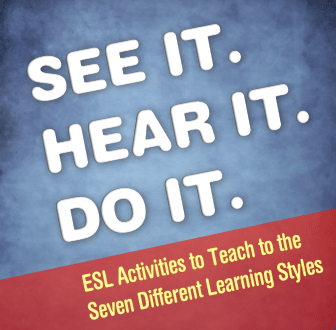See it, Hear it, Do it: ESL Activities to Teach to the Seven Different Learning Styles


While it may be true that a person today can simply use a translation website or app on their phone to quickly assimilate basic information, true interaction comes only with the learning and practicing of another dialect in a frequent manner.
ESL teachers, as they are known, are ideally instructors who must be a native or near-native speaker of English, or possess advanced-level English language proficiency. As such, they also need to develop a certain repertoire of activities designed to help their students more quickly pick up the English language, both in its basic context and also with regards to the dizzying array of slang and alternate meanings present.
It seems to be almost imperative to go beyond the basic "lecture and quiz" format so prevalent in traditional education systems. While learning to read, ‘remember and repeat’ may develop a student's memory, a teacher today needs to engage so much more of their collective class brainpower.
Using word and sentence games is a powerful method for language learning. Vocabulary and picture games help to develop mental association with terms and phrases, and the visual hands-on approach works well. Even basics like crossword puzzles, searches, and scrambles go a long way toward making a permanent imprint on the student's mind.
Training your class to actively listen can be a powerful exercise. Taking a field trip to virtually any public place where English is spoken simply for the express purpose of soaking up the various conversations can be very stimulating. Have everyone take notes and repeat back what they wrote upon your return. This will instill dictation skills and develop the ability to listen carefully for the purpose of remembering what was said. Extra credit if your destination also happens to be a library, where a world of literature awaits the eager mind. Have them dive into everything from periodicals to college books to fiction.
As your students progress past the basics, intermediate techniques can become very fun to implement. Have students create their own examples or analogies when trying to understand and remember a general concept or vocabulary definition. This not only helps students remember the concept better, but also helps them check their own understanding. Show your students the 'how', 'when' and 'why' to use language learning strategies, and to evaluate and monitor their own learning.
For memory training, have students learn how to group items into categories in order to memorize them. If they have a long list of things to memorize, show them how to group similar items together or to use anagrams for memory recall. Don't be afraid to get a little crazy with your class! Karaoke is a wonderful way to combat shyness and boost self-confidence -- any study of music is a great way to break the ice and facilitate word recognition. Encourage the students to participate in singing outside the classroom, too!
One thing to keep in mind is that it is the instructor’s responsibility to help students by providing activities and exercises that would encourage them to think and recall what they have learned from class before. Revisiting previous lessons in an overview keeps information from becoming nothing more than forgettable blocks of data in the student's mind, and lets it all flow and intermingle, tying what has already been learned with the upcoming instruction.
Another helpful tool is a prepared tape with words left out, combined with a matching worksheet; students can use words they have just heard to reassemble the transcript. You can even set up a felt board with a word list to encourage these students to develop their visual learning skills as well. Remember, though, that as a rule your class may need to learn informal spoken English to understand some written material, so try to keep things basic at first.
Story building games are perhaps the most fun; students fill in the blanks in the sentences with words to complete the meaning -- sometimes the results are unexpected! This can also be a team effort project. Try quizzes, too: the students can pair off and test their knowledge while adding to their social abilities in an English language setting. Variety is your friend, as more depth in your repertoire of teaching style will reach more students.
Simple board games based on familiar favorites, such as Grammatical Chutes and Ladders, can also help these students learn while enjoying a game, as well as humorous comics and other pictures with captions that can be rewritten to expand vocabulary -- get ready for giggles! Humor in the English language can be extremely instructive. A study of puns, for instance, can help students differentiate between similar sounding words.
Thanks to our current technology state, the use of chatting and webcams are quickly replacing traditional methods of commuting and gathering, and the realm of education is no exception. Several years ago, one creative blogger posted a comprehensive list of ESL learning aids that instructors could implement over webcam. In addition to the basics of video conferencing for the purposes of general instruction and surveys, ideas such as creating a video diary, writing a collaborative story or even recording a persuasive argument were presented.
Instructors looking for innovation in their techniques would really benefit from having a look at similar methods, as the concept of keeping the learning process fun and interesting is increasingly important in today's world of myriad distractions. If you can master the trick of getting your students so engrossed and fascinated with conquering the challenges you present to them, your job becomes much less difficult.
One excellent resource is the BBC page on Learning English, where a multitude of daily words, phrases and other tools are available, including lessons in general and business English, news stories with grammar, vocabulary and pronunciation exercises, quizzes and the fun animated series “Flatmates”. Similar themes can be found at the ManyThings.org page, assembled by two ESL teachers and featuring anagrams and a random-sentence generator, among many other items.
ESL learners improve their fluency when they have opportunities to speak, so trust your teaching abilities, and pair and share activities after your talk. This will help ESL learners to check their comprehension with a buddy and build friendships at the same time. Before you know it, you will have a class of grateful students that look up to you for your outstanding language instruction.